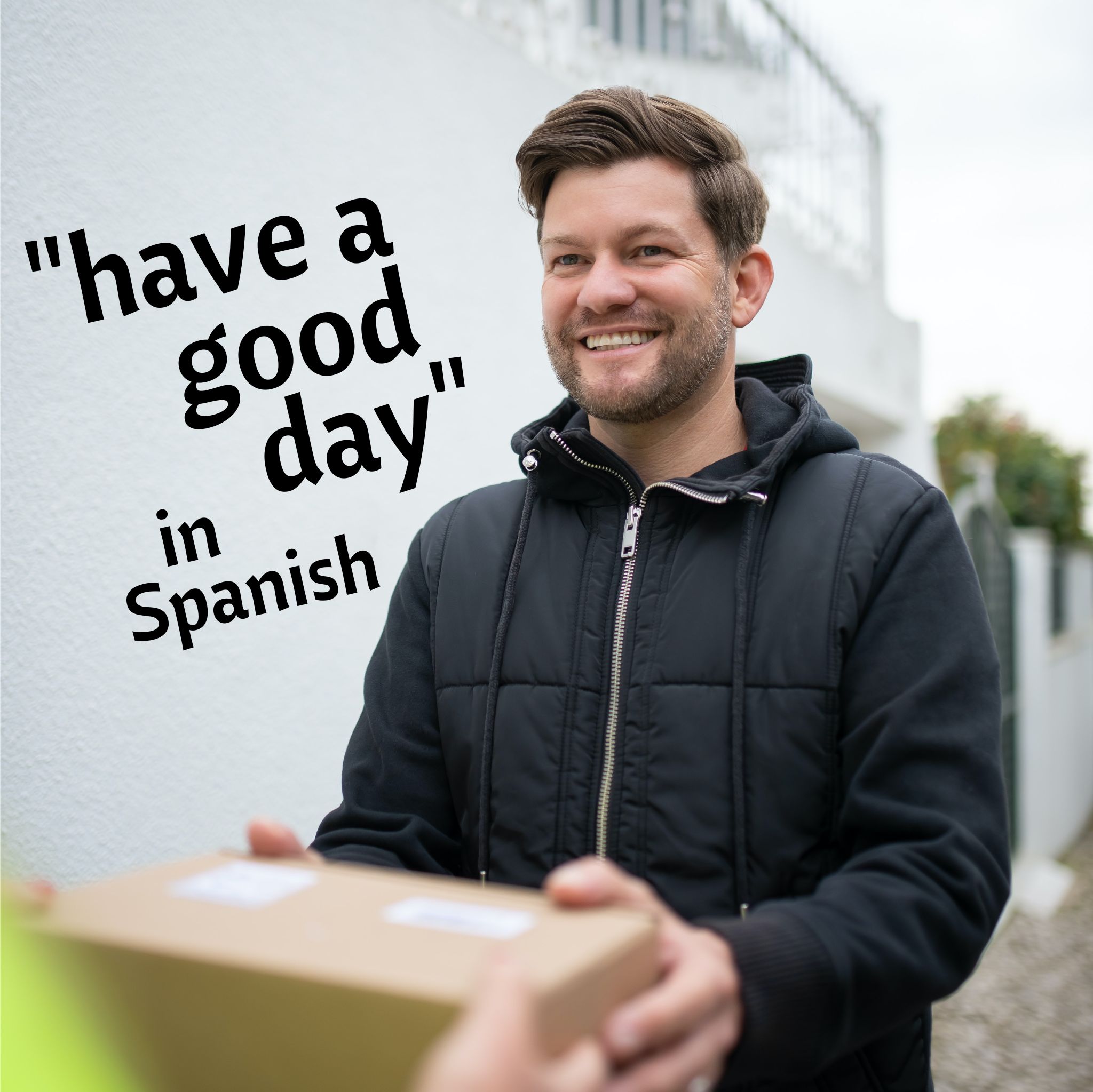¡Que tengas un buen día!: 10 ways to say Have a Good Day in Spanish

Get our free email course, Shortcut to Conversational.
Have conversations faster, understand people when they speak fast, and other tested tips to learn faster.
More infoOne of the fun parts of learning a language is being able to converse and interact with other people in everyday situations. Learning how to say have a good day in Spanish offers you an easy expression that you’ll hear regularly, and that you can quickly use on a daily basis yourself.
Whether you just finished shopping in a store and want to wish the cashier well as you leave, or you are greeting a friend or a neighbor, knowing how to say have a nice day in Spanish will be a positive addition to your everyday interactions.
In this post we’ll introduce 10 different ways to say have a good day in Spanish. We’ll start off with a quick look at some of the grammatical considerations to keep in mind so you understand them better and avoid some common mistakes. Then we’ll get into all our different options to wish someone a nice day in Spanish that will surely enrich your interactions with native speakers. Finally, we’ll finish with some pointers on other useful expressions and greetings in Spanish.
Here we go!
Have a good day in Spanish: Grammar notes
Before we get into how to say have a good day in Spanish, let’s just start with a couple of basic grammar details that apply across the board.
The first detail we need to note is the level of formality. As you may know, we have two options for the singular you in Spanish. Tú is the informal you, reserved for friends, peers, or children, whereas usted is the formal you for strangers, elders, or authority figures. Where the expression has both forms, we’ll provide both the tú and usted versions of our Spanish have a good day phrases.
The next grammar detail is that many of these phrases rely on the Spanish subjunctive. While we won’t go into detail on the subjunctive mood in this post, we’ll at least say that it’s used here because we’re expressing our hopes and wishes that the other person may have a nice day in Spanish.
Finally, a note on the construction of many of our phrases that begin with the word que. Que tengas un buen día, for example, is actually an abbreviated version of Yo espero que tengas un buen día, meaning essentially I hope that you may have a good day in Spanish. The hope is usually just implied, since the introductory que and subsequent subjunctive conjugation are enough to convey the intent. Remember that this que never takes an accent (the accented qué is a question word meaning what in Spanish).
Que tengas un buen día, Que tenga un buen día
This is the most common way to say have a good day in Spanish. The verb tener means to have in Spanish, so this expression translates literally as may you have a good day. Another common variant is que tengas buen día, dropping the indefinite article un.
This expression can be used in a wide range of contexts, such as wishing a good day to a friend as you part ways, or after receiving a package from the mailman.
Que tengas un buen día is the tú version for addressing someone you’re familiar with, whereas if you want to address someone more formally with usted, use que tenga un buen día instead.
- ¡Adiós, querido! Ya me voy. / ¡Adiós! Que tengas un buen día. – Bye, darling! I’m leaving now. / Bye! Have a good day.
- Aquí está su paquete, señora. / Gracias, que tenga un buen día. – Here’s your package, ma’am. / Thank you, have a good day.
Que tengas un bonito día, Que tenga un bonito día
So, how do you say have a nice day in Spanish? Que tengas un bonito día is probably the closest expression. It translates literally as have a pretty day, so a common variant trades bonito for its synonym lindo, both of which mean pretty in Spanish: que tengas un lindo día. Like we saw for the previous expression, another variant also omits the indefinite article: que tengas bonito día.
Again, pay attention to the level of formality to choose between the tú and usted options.
- ¡Qué bueno fue verte! Tenemos que volver a salir pronto. ¡Adiós! / ¡Lo mismo digo! Que tengas un bonito día. ¡Hasta pronto! – It was so good to see you! We have to go out again soon. Bye! / I say the same! Have a nice day. See you soon!
- Muchas gracias por su ayuda, joven. / No hay de qué. Que tenga bonito día. – Thank you very much for your help, young man. / You’re welcome. Have a nice day.
Que pases un buen día, Que pase un buen día
This option is basically the same as the first one, but with a small verb change. Pasar means to spend [time], so instead of wishing someone to have a nice day, we wish for them to spend a nice day. In English, this still translates best as another version of have a good day in Spanish. As with the other two, we can also drop the indefinite article: que pases buen día.
- ¡Chao, Joana! Nos vemos. / ¡Nos vemos! Que pases un buen día. – Bye, Joana! See you. / See you! Have a good day.
- Adiós, doctor. Que pase un buen día. / Hasta mañana, Ramírez. Igualmente. – Goodbye, doctor. Have a good day. / See you tomorrow, Ramírez. Same to you.
Que pases un bonito día, Que pase un bonito día.
After learning the previous three expressions, hopefully you can interpret this one now! Yes, here the literal translation is may you spend a pretty day, though in English it’s still best interpreted as have a nice day in Spanish. The same rules on formality and on dropping the indefinite article apply here too.
- ¡Feliz cumpleaños, Julieta! Que pases un bonito día. / ¡Muchas gracias, Sofi! – Happy birthday, Julieta! I hope you have a nice day. / Thank you, Sofi!
- Gracias por visitar nuestro museo. Que pase un bonito día. – Thank you for visiting our museum. Have a nice day.
Buen día
This expression translates directly as good day, and although it’s mostly known as a greeting, it can also be a short-and-sweet option for how to say have a good day in Spanish. In fact, buen día is a shortened version of que tengas un buen día.
Since it has no verb, there’s no differentiation between tú vs usted. It’s kind of a casual expression, though perhaps still a bit too formal to be used with family and friends.
- Gracias por la información. Buen día. / A su servicio. Hasta luego. – Thank you for the information. Good day. / You’re welcome. See you later.
- Hasta mañana, jefe. Buen día. / Buen día para ti también. Adiós. – See you tomorrow, boss. Good day. / Good day to you too. Goodbye.
Bonito día, Lindo día
Similar to the previous expression, these are other short and formal expressions to wish someone a nice day in Spanish. Likewise, they’re the shortened forms of the two version of que tengas un bonito día that we saw above. Both abbreviated versions, bonito día and lindo día, are equally common.
- Muchas gracias por su compra. Bonito día. / A usted. Igualmente. – Thank you for your purchase. Have a nice day. / Thanks to you. Likewise.
- Hasta luego, señora Miriam. Ya llegó mi taxi. / Hasta luego, Diana. Lindo día. – See you later, Mrs. Miriam. My cab is here. / See you later, Diana. Have a nice day.
Feliz día
Feliz día literally means happy day. This expression is most common in retail contexts, as a farewell after a transaction is done, as a short and sweet alternative to thank you have a good day in Spanish. It’s not so common to hear feliz día in other contexts than retail, though it’s still a possible option.
- Muchas gracias por la comida, estuvo deliciosa. / Estamos para servirle. Feliz día. – Thank you very much for the meal, it was delicious. / At your service. Have a nice day.
Que te vaya bien, Que le vaya bien
This expression literally means I hope it goes well for you. However, it can be translated in different ways depending on the context.
It can mean have a good one in Spanish when we wish someone to enjoy an occasion or succeed at an event, such as a holiday or a trip. Alternatively, it can also mean all the best in Spanish, used as a way to wish someone luck. The object of the best wishes in either of these uses is often implied from the context in Spanish, whereas in English you may state it.
Still, we can also just use this expression on a regular day, simply wishing someone well. In this sense, que te vaya bien is yet another option for how to say have a good day in Spanish.
Grammatically, we differeniate the tú and usted versions by their respective indirect object pronouns te and le: the tú version is que te vaya bien, while for usted it’s que le vaya bien.
- Ya me voy a la escuela, mamá. Hoy tengo un examen. / Adiós hijo. Que te vaya bien. – I’m going to school now, Mom. I have a test today. / Bye, son. All the best on your test.
- Ya está reparado su reloj. Aquí lo tiene. / Muchas gracias, que le vaya bien. – Your watch is fixed. Here it is. / Thank you very much, have a nice day.
- ¡Mañana me voy de viaje a Roma! / ¡Genial! Que te vaya bien. – Tomorrow I’m going on a trip to Rome! / Great! Have a good trip.
Que estés bien, Que esté bien
This expression translates directly as [I hope] you shall be well, or simply as be well. Although this expression is not strictly another version of have a good day in Spanish, it’s still used as a way of wishing someone to be fine that’s generally used as a farewell. So in its own way, it serves the same function.
The level of formality varies between the tú and usted forms: que tú estés bien for peers, or que usted esté bien in formal interactions.
- Chao, Mariana. Tengo que ir a casa a cuidar a mi hermano. / Chao, Natalia. Que estés bien. – Bye, Mariana. I have to go home to babysit my brother. / Bye, Natalia. Be well.
- Este es el jarabe para la tos que debe comprar. Puede llamarme si tiene alguna duda. / Muchas gracias, doctor. Que esté bien. – This is the cough syrup you need to buy. You can call me if you have any doubts. / Thank you so much, doctor. Be well.
Bonus: Thank you, You’re welcome, and Greetings
While perhaps you decided to read this post wondering how do you say have a good day in Spanish?, you may have noticed that most of these expressions are regularly used in contexts where you’d be glad to have some additional vocab. You probably already figured out that Thank you, have a good day in Spanish is Gracias, que tengas un buen día, but why leave it at that?
To help you make the most of these related expressions, we’ll leave you with links to some of our similar posts where we introduce 13 different ways to say thank you in Spanish, 13 ways to say you’re welcome in Spanish, and our ultimate guide to greetings and goodbyes in Spanish.
You can never know too many Spanish expressions!
Conclusion
Good job, it looks like we’ve reached the end. Now you no longer wonder how do you say have a nice day in Spanish, right? How about a quick review to wrap things up?
First of all, remember that most of the expressions we saw today can be conjugated with tú or usted versions, meaning that the degree of formality varies. They’re also conjugated in the subjunctive, so they rely on the unaccented que which precedes the rest of each phrase.
We learned that que tengas un buen día is the most common way to say have a good day in Spanish. We then saw several variants, whether exchanging tengas for pases, or using bonito or lindo instead of buen, or even dropping the first half of the expression to just say buen día, bonita día, or lindo día. Altogether, these provide us with a nice variety of ways to say have a good day or have a nice day in Spanish.
The last few expressions were a bit different, though still with the same intent of wishing someone well. And since these phrases are all used in contexts where we greet and thank people, we provided links to several of our other posts with even more useful Spanish expressions.
Keep studying, and you’ll quickly master a nice variety of expressions for wishing people all the best in Spanish. – Que te vaya bien!



